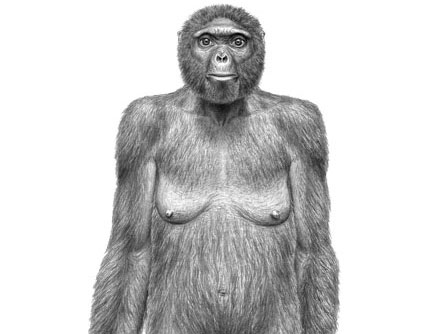Meet your mysterious relative
Ardi climbed trees and walked on two legs 4.4 million years ago
Her scientific name is Ardipithecus ramidus, and scientists call her Ardi for short. She is ancient — her bones are 4.4 million years old — and is making scientists think about the distant past in a whole new way.
Ardi is an example of an extinct species that may help scientists understand how human beings evolved the way we did. She is a hominid, which means she belongs to the same evolutionary family as people. It’s not clear whether Ardi was a direct ancestor of humans.

Scientists have just published more than a dozen studies on Ardi’s species — and this is just the first wave. Ardi’s skeleton is so surprising that “no one could have imagined it without direct fossil evidence,” says Tim White, an anthropologist at the University of California, Berkeley, who has studied Ardi. (An anthropologist is a scientist who studies human beings and their ancestors.)
Ardi first started to show up in 1992, when scientists found her fossilized teeth in Ethiopia. In 1994, her hand bone was found. For three years after that, scientists worked to remove more of her skeleton, including her arms, hands, pelvis, legs and feet. She was believed to be female because she had a relatively small skull and small canine teeth. Between 1981 and 2004, scientists removed other skeletons of other individuals of the same species from the same area. They also removed fossils of other animals and of plants.
White says Ardipithecus looks different from any living primate, so it’s hard to get an idea of Ardi’s appearance by looking at modern primates such as monkeys or apes.
Some scientists have believed that the common ancestor of people and apes resembled a chimpanzee, but Ardi shows that idea may not be true. Ardi’s partial skeleton that scientists have found shows that she could walk upright and easily climb trees and move along branches — traits more easily identified in monkeys or apes. It also shows that Ardi probably couldn’t swing from branch to branch.
“It now seems that the last common ancestor of chimpanzees and humans was much less chimplike than previously thought,” says Alan Walker, an anthropologist at Pennsylvania State University in University Park.
White and his team think Ardi probably stood almost four feet tall and weighed about 110 pounds. This means Ardi is significantly larger than Lucy, a partial skeleton from a different species that lived on Earth 3.2 million years ago. Lucy was also found in Ethiopia. Even though Lucy and Ardi came from different species, they are probably related. Scientists may be able to use information from Ardi’s discovery to learn more about how Lucy’s species evolved.
Owen Lovejoy, an anthropologist at Kent State University in Ohio, also thinks scientists can learn a lot from Ardi’s teeth. He says small canines — especially in the males of the species — suggest that the males rarely fought. Male apes with large canines often show their teeth when they’re fighting over females.
In Ardi’s teeth, Lovejoy sees the beginning of an evolutionary process that led to human beings. “This is one of the most revealing hominid fossils that I could have imagined,” he says.







